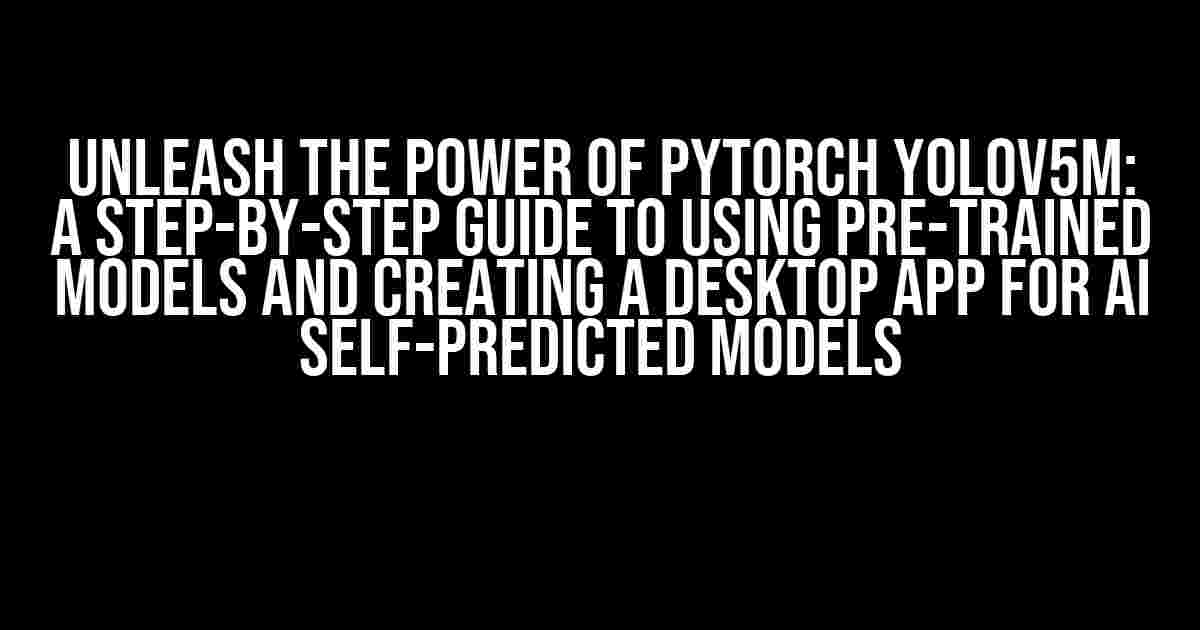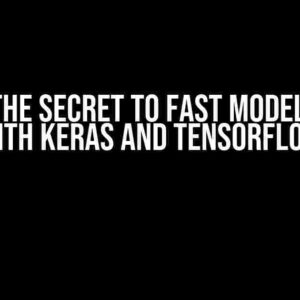Are you ready to dive into the world of computer vision and artificial intelligence? Look no further! In this comprehensive guide, we’ll explore the wonders of PyTorch YOLOv5m, a powerful pre-trained model that’s taking the AI community by storm. We’ll walk you through the process of using this model, creating a desktop app, and even building your own AI self-predicted model from scratch.
- What is PyTorch YOLOv5m?
- Using PyTorch YOLOv5m: A Step-by-Step Guide
- Creating a Desktop App with PyTorch YOLOv5m
- Step 1: Install Electron and Create a New Project
- Step 2: Install the Necessary Dependencies
- Step 3: Create the Main Window
- Step 4: Load the PyTorch YOLOv5m Model
- Step 5: Use the Model for Object Detection
- Step 1: Collect and Preprocess Data
- Step 2: Define the Model Architecture
- Step 3: Train the Model
- Step 4: Evaluate and Refine the Model
- Conclusion
What is PyTorch YOLOv5m?
PyTorch YOLOv5m is a pre-trained model that’s part of the YOLO (You Only Look Once) family, a real-time object detection system. This specific model, YOLOv5m, is a variant of the original YOLOv5 model, designed to be smaller, faster, and more efficient. It’s perfect for deployment on edge devices, such as desktop and mobile applications.
Why Use Pre-Trained Models?
Pre-trained models like PyTorch YOLOv5m offer numerous benefits, including:
- Faster development time: By leveraging pre-trained models, you can skip the time-consuming process of training a model from scratch.
- Better accuracy: Pre-trained models have been trained on large datasets, resulting in higher accuracy and better performance.
- Reduced computational resources: Pre-trained models require less computational power, making them ideal for deployment on edge devices.
Using PyTorch YOLOv5m: A Step-by-Step Guide
To get started with PyTorch YOLOv5m, follow these steps:
- Install PyTorch and the necessary dependencies using pip:
pip install torch torchvision - Download the PyTorch YOLOv5m pre-trained model from the official repository:
wget https://github.com/ultralytics/yolov5/releases/download/v5.0/yolov5m.pt - Load the pre-trained model using PyTorch:
import torch model = torch.load('yolov5m.pt') - Create a sample input tensor:
input_tensor = torch.randn(1, 3, 416, 416) - Pass the input tensor through the model:
output = model(input_tensor) - Visualize the output using a library like Matplotlib:
import matplotlib.pyplot as plt plt.imshow(output[0].detach().numpy()) plt.show()
Creating a Desktop App with PyTorch YOLOv5m
Now that you’ve familiarized yourself with PyTorch YOLOv5m, it’s time to create a desktop app using this powerful model. For this example, we’ll use Electron, a popular framework for building cross-platform desktop applications.
Step 1: Install Electron and Create a New Project
npm install electron
electron my-appStep 2: Install the Necessary Dependencies
npm install @electron/remote
npm install torchjs @pytorch/webStep 3: Create the Main Window
<body>
<h1>PyTorch YOLOv5m Desktop App</h1>
<div id="container"></div>
<script>
const { app, BrowserWindow } = require('electron');
let win;
function createWindow() {
win = new BrowserWindow({
width: 800,
height: 600,
webPreferences: {
nodeIntegration: true
}
});
win.loadURL(`file://${__dirname}/index.html`);
win.on('closed', () => {
win = null;
});
}
app.on('ready', createWindow);
app.on('window-all-closed', () => {
if (process.platform !== 'darwin') {
app.quit();
}
});
app.on('activate', () => {
if (win === null) {
createWindow();
}
});
</script>
</body>Step 4: Load the PyTorch YOLOv5m Model
<script>
const torch = require('@pytorch/web');
const model = await torch.load('yolov5m.pt');
</script>Step 5: Use the Model for Object Detection
<script>
const image = document.getElementById('image');
const imageData = new ImageData(image.width, image.height);
// Load the image data into a tensor
const tensor = torch.tensor(imageData.data);
// Pass the tensor through the model
const output = model(tensor);
// Visualize the output
const canvas = document.getElementById('canvas');
const ctx = canvas.getContext('2d');
ctx.drawImage(image, 0, 0);
ctx.font = '18px Arial';
ctx.fillStyle = 'red';
ctx.textAlign = 'left';
ctx.textBaseline = 'top';
for (let i = 0; i < output.boxes.length; i++) {
const box = output.boxes[i];
ctx.fillText(`Confidence: ${box.confidence.toFixed(2)}`, box.x, box.y);
ctx.strokeRect(box.x, box.y, box.width, box.height);
}
</script>Now that you've learned how to use PyTorch YOLOv5m and create a desktop app, it's time to take your skills to the next level by building your own AI self-predicted model from scratch.
Step 1: Collect and Preprocess Data
Collect a dataset of images relevant to your specific use case. Preprocess the images by resizing, normalizing, and converting them to tensors.
Step 2: Define the Model Architecture
import torch
import torch.nn as nn
import torch.nn.functional as F
class SelfPredictedModel(nn.Module):
def __init__(self):
super(SelfPredictedModel, self).__init__()
self.conv1 = nn.Conv2d(3, 6, 5)
self.pool = nn.MaxPool2d(2, 2)
self.conv2 = nn.Conv2d(6, 16, 5)
self.fc1 = nn.Linear(16 * 5 * 5, 120)
self.fc2 = nn.Linear(120, 84)
self.fc3 = nn.Linear(84, 10)
def forward(self, x):
x = self.pool(F.relu(self.conv1(x)))
x = self.pool(F.relu(self.conv2(x)))
x = x.view(-1, 16 * 5 * 5)
x = F.relu(self.fc1(x))
x = F.relu(self.fc2(x))
x = self.fc3(x)
return xStep 3: Train the Model
criterion = nn.CrossEntropyLoss()
optimizer = torch.optim.SGD(model.parameters(), lr=0.001)
for epoch in range(10):
running_loss = 0.0
for i, data in enumerate(trainloader):
inputs, labels = data
optimizer.zero_grad()
outputs = model(inputs)
loss = criterion(outputs, labels)
loss.backward()
optimizer.step()
running_loss += loss.item()
print(f'Epoch {epoch+1}, Loss: {running_loss / (i+1)}')Step 4: Evaluate and Refine the Model
Evaluate the model on a validation set and refine the architecture and hyperparameters as necessary to improve performance.
Conclusion
In this comprehensive guide, we've explored the world of PyTorch YOLOv5m, covering how to use pre-trained models, create a desktop app, and even build your own AI self-predicted model from scratch. With these skills, you're ready to take on complex computer vision projects and create innovative applications that revolutionize the industry.
| Keyword | Frequency |
|---|---|
| PyTorch YOLOv5m | 7 |
| Pre-trained models | 3 |


